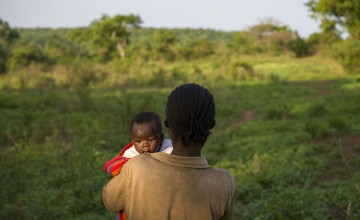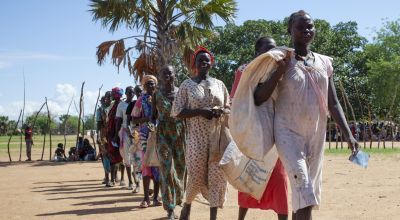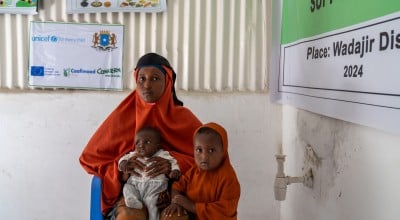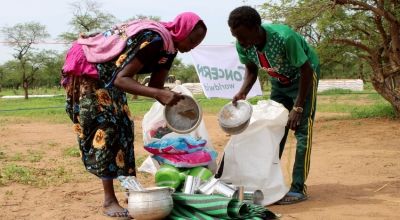
Read our 2024 annual report

Knowledge Hub
Conflict and hunger exist in a back-and-forth relationship where one increases the other. Unfortunately, in 2023, both are on the rise.
After years of global hunger numbers going down, we’ve seen an increase over the last few years. Pre-pandemic, conflict was the largest contributing factor to food insecurity. Last year, global military spending hit an all-time high after eight consecutive years of increase.
This connection isn't new: Angola and Rwanda both experienced large-scale civil wars in the 1990s and 2000s. With a decrease in violence, a significant fall in hunger levels followed. Conversely, Somalia and the Central African Republic have some of the highest levels of hunger in the world. Both have experienced years (in Somalia’s case, decades) of conflict and political unrest.
Without food security, lasting peace is not possible. Without an end to conflict, we’re also not likely to reach zero hunger. Here are five key ways in which conflict and hunger work together — to deadly consequences.
1. Conflict destroys agriculture
One of the most direct effects that conflict has on hunger is also the most tangible. Among the countries currently affected by conflict, approximately 60% of residents live in rural areas and rely on agriculture. This means that entire communities are vulnerable to the effects of conflict.
In the Central African Republic, 80% of the population relies on subsistence agriculture and livestock. This is a devastating number when you consider that the country is more than a decade into a civil war that shows no signs of ending. Fighting has destroyed villages, irrigation infrastructure, and crops.
Even if the land and crops are safe and families don't flee their home, running a farm is a labor-intensive job. Civilian injuries during conflict are common, and can often leave people unable to work the land — sometimes for the rest of their lives.

2. Conflict interrupts food supply chains and economies
When the conflict in Ukraine began early last year, one of the countries most affected was over 8,000 kilometers away. Together, Ukraine and Russia produce a large amount of the global grain supply. Before 2022, Somalia typically sourced between 90 and 95% of its grain from Ukraine and Russia. Imports from both of those countries were halted due to the conflict. Even if a country is able to produce many of its staples domestically, conflict can lead to lockdowns, internal border closures, and movement restrictions that disrupt local food systems, lead to food waste, and destroy livelihoods. The tail-end of these economic impacts is inflation.
Conflict makes day-to-day life unpredictable, which can also lead to economic instability. Even families with higher incomes may hedge their bets in response. In Burundi, farmers of all economic situations switched to low-risk, low-return crops. The goal was to survive rather than thrive. Such crops allowed for quicker harvests and immediate results, but they also hurt incomes and diets for generations.

3. Conflict leads to displacement leads to food insecurity
People displaced by conflict are more vulnerable to hunger and undernutrition. In one study from Nigeria's Yobe state, children living in internal displacement were 57% more likely to have acute malnutrition than children in host communities.
In host communities, refugees often face challenges based on their legal status and language barriers. Without work or formal resources, their living situations are often compromised. After more than a decade of conflict in Syria, many middle-class families gave up everything to escape to neighboring countries. These circumstances have pushed them below the poverty line and struggling to feed their families. Many receive food distribution and nutritional support from NGOs. However, with humanitarian financial commitments lagging, this isn't a long-term solution.

4. Conflict disproportionately affects child hunger and nutrition
It's not just about the immediate lack of food. A poor diet (both quality and quantity) leaves children especially vulnerable. Their bodies and minds are still growing, and that growth requires energy in the form of food. Without food, they may be stunted physically and/or intellectually. They also become more susceptible to other illnesses and face higher mortality rates than adults.
This is a link between conflict and hunger that's well-documented. In Somalia, data from 2007-10 showed that conflict increased both child stunting and wasting rates. A 2013 study from Nigeria showed that states affected most by conflict had child wasting rates of 23%; in non-conflict areas, the rates were as low as 10%. Reports from 2019 showed similar rates in Afghanistan and Yemen.
While conflicts have grown more localized, these effects of violence can be felt in children living as far as 60 miles away. They can also impact children born as late as eight years after the conflict ends.
5. Conflict can increase in areas affected by food insecurity
Conflict and hunger form a vicious cycle. Conflict not only drives up hunger levels. Rising hunger levels also lead to grievances that can escalate to violence. As violence escalated in Haiti through 2019, UN reports that year predicted a nearly 10% increase in hunger levels for 2020. This was before COVID-19, and by the beginning of 2021, the increase in hunger in Haiti was closer to 20%.
Part of the current crisis in Haiti has been fueled by this food shortage and inflation. Year-over-year, food prices rise, unregulated, by 30%. A recent World Food Programme report estimated that a working person in Haiti paid 35% of their daily income on one meal. That's akin to someone in New York paying $74 for lunch.

Conflict and hunger: Breaking the cycle
The causes of conflict and hunger in each country — even community — are unique. Because of this, recovery takes time. The World Bank estimates between 15 and 30 years. This is an equally fragile period of peacetime, where ongoing food shortages or other issues can reignite old disputes. Signing a peace treaty is only the first step in a long road to recovery. It's also why we must continue to work towards establishing a peace strengthened by food systems, and food systems strengthened by peace.
When conflict strikes, Concern seeks out the most-affected and hardest-to-reach communities to meet their immediate needs. We also work with them to design innovative, fast, and effective responses that fit both long- and short-term scenarios. In places that host internally-displaced civilians or refugees, we help to ensure that people forced to leave home have the support they need, while also working with host communities to ensure that they also have enough resources.
This piece is adapted in part from Caroline Delgado and Dan Smith’s essay, “Hunger and Food Systems in Conflict Settings,” published by Concern Worldwide and Welthungerhilfe as part of the 2021 Global Hunger Index.
Help us end the wait for families facing catastrophic hunger





